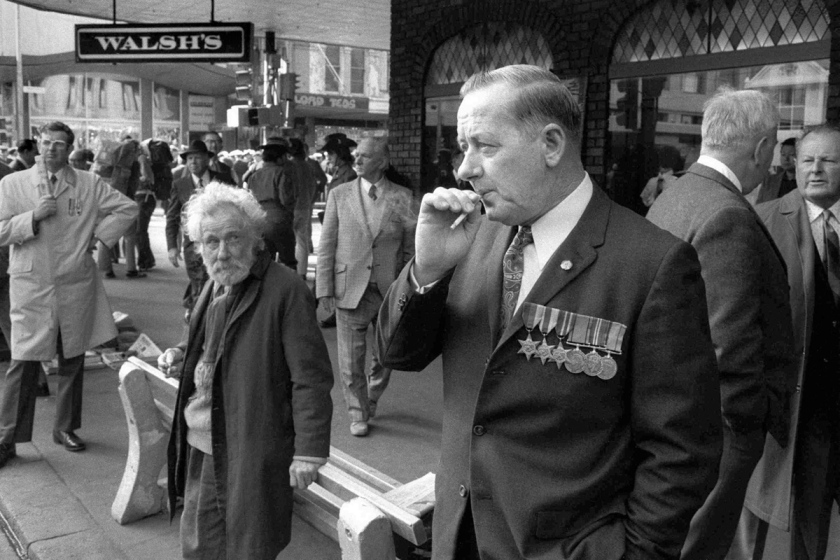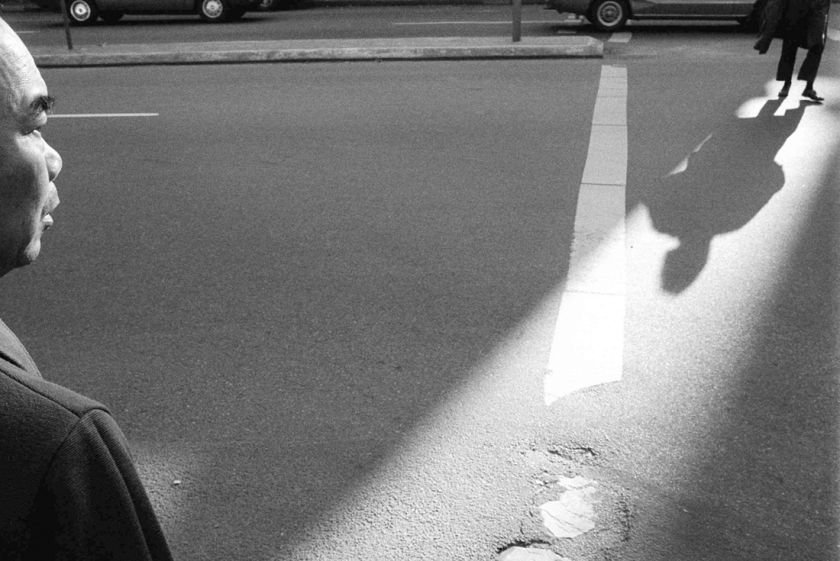Exhibition dates: 14th June – 7th July 2018
Curator: Merle Hathaway
John Williams (Australian, 1933-2016)
Paper Seller, Farmer’s Building, Sydney
1965
Silver gelatin print
© John Williams
An Australian Classic
When I think of Australian photography, I invariably think of four themes / concepts / era: Pictorialism, Modernism, contemporary (mainly talented female artists) … and street photography. In the latter category, the artist John Williams is an Australian classic. Personally, I have never had the facility or confidence to be a street photographer. It takes a particular kind of person with a very special “eye” to be successful in this genre of photography. Williams had that “eye” in spades.
This retrospective of his work at Magnet Galleries in downtown Melbourne Central Business District is fascinating. You know that you are having a good time at an exhibition when you walk around looking at image after image and chortling to yourself. And laughing out loud. While the quality of some of the prints might not be the best in the world, the aesthetic, fun and irony which the images contain more than make up for it. To actually see these compositions in a spilt second and recognise them for what they are, in that instant, is incomparable.
The paper seller with the woman top right, the woman half appearing at left, the table in the distance and the vanishing point far left. The woman in Paddington with her hand on her hip, looking at the camera and thinking to herself, “what the hell do you think your doing”. The man at Clovelly Beach sunning himself in all his masculinity, not knowing that there is another man with his legs spread in shot behind him. Oh the irony! My particular favourite is the photograph Anzac Day, Melbourne (1965, below) in which what looks like a homeless man, fag in hand, casts a disparaging look towards a veteran in suit and tie displaying all his medals. You can just hear him thinking: “what a tosser”. There are many more: the hand and expression on the face of the women second from the right in Rocks Pub Crawl, Sydney (1973, below) and the disparaging grimace of the man on the left in St Kilda (1975, below). The look on the attendant’s face in front of the Leonardo da Vinci Mona Lisa is an absolute cracker.
Williams’ street photography emerged out of the culture that inspired it. In his photographs we can observe the White Australia policy, the remains of British Empire in the stiff upper lip of ANZAC veterans, powerful white men sitting behind desks with nameless female secretaries, rebellious youth culture, the informality of beach culture and the larrikinism of pub crawls everywhere in Australia. While “Williams embraced the ‘element of chance’ or the ‘decisive moment’ (Cartier-Bresson) … to socially document the raw character of Australia”, in so doing investigating the myth of national identity, his photographs are much more complex than traditional street photography.
There is a much more formal, classical aesthetic going on in these photographs than in other street photography, for example the work of the Americans Lee Friedlander and Garry Winogrand. Here is an artist who, while working with a necessary immediacy, implicitly understands the formal composition and structure of the image plane. Williams loves his off-centre vanishing points, he loves spatially layering the image, and understands how the eye of the viewer wanders across the surface of the image. Look at the two images of the beach, Bondi Beach, Sydney (1964, below) and Clovelly Beach (1964, below) and just let your eye play over the diagonals and verticals, the negative and positive spaces, the ways of escape that the eye has out of each image. The shadow of the two heads ground the first image, while the space either side of the lying man at the top of the image allows your eye to escape the strong diagonal below; while in the second image the horizon line is breached by the sitting woman. If she were not there the image would not work.
Williams’ photographic work deserves to be better known. Here is a talented man who as a historian wrote many books on the First World War; a far sighted man who (with film maker Paul Cox and Rod McNicol), established one of the first commercial fine art photography galleries in Melbourne (The Photographers’ Gallery, Punt Road, South Yarra) in 1973; and a man who took damn good photographs that held a mirror up to Australian culture at that time, which question Australian identity through humour and irony balanced by a complex, classical aesthetic.
Dr Marcus Bunyan
Many thankx to John Williams’ widow Jean Curthoys, curator Merle Hathaway, Michael Silver and Magnet Galleries for allowing me to publish the photographs in the posting. Please click on the photographs for a larger version of the image.
John Williams (Australian, 1933-2016)
Paddington
1962
Silver gelatin print
© John Williams
John Williams (Australian, 1933-2016)
Clovelly Beach
1964
Silver gelatin print
© John Williams
John Williams (Australian, 1933-2016)
Clovelly Beach
1964
Silver gelatin print
© John Williams
John Williams (Australian, 1933-2016)
Bondi Beach, Sydney
1964
Silver gelatin print
© John Williams
John Williams (Australian, 1933-2016)
Open Air Shower, Bronte Beach
1964
Silver gelatin print
© John Williams
John Williams (Australian, 1933-2016)
Anzac Day, Sydney
1964
Silver gelatin print
© John Williams
John Williams (Australian, 1933-2016)
Anzac Day, Martin Place (also titled Sydney)
1964
Silver gelatin print
© John Williams
Sydney photographer, lecturer and historian John F. Williams has a long and personal interest in the ramifications of the Allies’ commitment to and sacrifice in the First World War which he later explored in his 1985 series From the flatlands. Williams became an amateur street photographer, inspired by Henri Cartier-Bresson and the photojournalist W. Eugene Smith. He read The family of man catalogue and saw the exhibition in 1959 but he rejected its “saccharine humanism and deliberate ahistoricism” choosing instead to socially document the raw character of Australia.1
When interviewed in 1994 Williams said: “After the [First World War] you had a range of societies which were pretty much exhausted, and they tended to turn inwards. In a society like Australia which had a poorly formed image of itself, where there was no intellectual underpinning, the image of the soldier replaced everything else as a national identity.”2
Sydney expresses the ‘Anzac spirit’ born in the battlefields of Gallipoli, the Somme and Flanders, a character study of an independent, introspective soldier. With an air of grit, determinedly smoking and wearing his badge, ribbons and rosemary as remembrance, Sydney stands apart from the crowd, not marching with his regiment. Williams embraced the ‘element of chance’ or the ‘decisive moment’ as he documented the soldier in a public place observing the procession. Taken from a low angle and very close up the man is unaware of the photographer at the moment the shot was taken, apparently lost in his own memories. The old soldier represents a generation now lost to history but portraits such as these continue to reinforce the myth of national identity.
1/ Jolly, M. “Faith sustained,” in Art Monthly, September 1989, pp. 18-19
2/ “John Williams – photographer and historian: profile,” in Sirius, winter, Macquarie University, Sydney, 1994, p. 5
© Art Gallery of New South Wales Photography Collection Handbook, 2007
John Williams (Australian, 1933-2016)
Anzac Day, Melbourne
1965
Silver gelatin print
© John Williams
Melbourne’s best photographic gallery, Magnet Galleries, will feature the work of two major Australian photographers, John Williams and Ingeborg Tyssen.
John Williams always wanted to hold an exhibition with his photographer wife, and sadly it did not occur during either of their lifetimes. Magnet Galleries, at 640 Bourke Street now fulfils this wish with a double exhibition running from 14 June to 7 July 2018.
The two exhibitions, “My last 60 years on the streets: John Williams Retrospective (1933-2016)” and “Swimmers: Ingeborg Tyssen (1945-2002)” feature their superb black and white photography. Both artists were keen observers of people in their environments and preferred the black and white format.
On the day she was fatally injured in an accident Tyssen was in Holland, learning to use her new digital camera. She died two days later with John at her side. Williams’ work was also darkroom generated until 2002 when he became concerned at the effects of chemicals on photographers. From then on he only used the digital format, and increasingly played with the effects of overlaying images and stitching multiple images.
Williams became well known for his 1960s and 1970s Sydney street scenes, and Anzac Day marches over the decades. He described himself as a photographer who wrote history and a historian who took photographs. He wrote seven books and many articles about World War 1. This exhibition will show the full extent of his legacy.
The exhibition at Magnet Galleries is organised by John Williams’ widow Jean Curthoys and curator Merle Hathaway.
John Williams (Australian, 1933-2016)
Tesiphon, Iraq
1965
Silver gelatin print
© John Williams
John Williams (Australian, 1933-2016)
Brighton Beach, Sussex
1967
Silver gelatin print
© John Williams
John Williams (Australian, 1933-2016)
Pisa
1968
Silver gelatin print
© John Williams
John Williams (Australian, 1933-2016)
Rozelle, Sydney
1968
Silver gelatin print
© John Williams
John Williams (Australian, 1933-2016)
Rocks Pub Crawl, Sydney
1973
Silver gelatin print
© John Williams
John Williams (Australian, 1933-2016)
Rocks Pub Crawl, Sydney
1973
Silver gelatin print
© John Williams
John Williams (Australian, 1933-2016)
St Kilda
1975
Silver gelatin print
© John Williams
John Williams (Australian, 1933-2016)
Louvre
1975
Silver gelatin print
© John Williams
John Williams (Australian, 1933-2016)
Chicago
1975
Silver gelatin print
© John Williams
John Williams (Australian, 1933-2016)
Haymarket, Sydney
1977
Silver gelatin print
© John Williams
John Williams (Australian, 1933-2016)
William McMahon, Australian Prime Minister
1971-1972
Silver gelatin collage
© John Williams
Photographed in his parliamentary office in 1980 when he was ‘Father of the House’
John Williams (Australian, 1933-2016)
Andrew Peacock and Secretary
1980
Silver gelatin collage
© John Williams
At the time of this photograph, Andrew Peacock was Minister for Foreign Affairs
John Williams (Australian, 1933-2016)
Ed Douglas (photographer)
1980
From the series Living Room Portraits, 1980
Silver gelatin collage
© John Williams
John Williams (Australian, 1933-2016)
Christine, Sydney
1980
From the series Living Room Portraits, 1980
Silver gelatin collage
© John Williams
John Williams (Australian, 1933-2016)
Anzac Day, Sydney
2000
Silver gelatin print
© John Williams
SC G19, Wharf st, The District, Docklands
Melbourne, Victoria, 3008
Australia
Phone: +61 3 8589 0371
Opening hours:
Tuesday – Saturday: 10am – 4pm

























You must be logged in to post a comment.